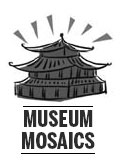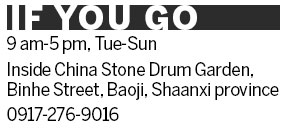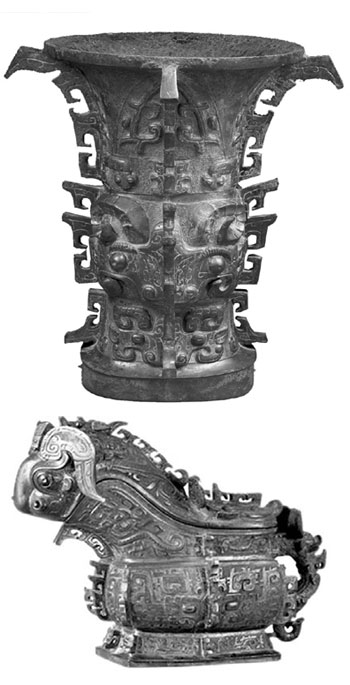Baoji's splendid bronzes
Updated: 2012-02-05 08:04
By Ni Na and Lu Hongyan (China Daily)
|
|||||||||||
|
The hezun (top), a grain measure and zhegong (above), a wine goblet, are two of the highlights of the Baoji Bronze Museum. The hezun was discovered by a local farmer in 1963 and the zhegong was excavated at Zhuangbai village in Fufeng county in 1976. Provided to China Daily |
Archaeologists are still unearthing priceless bronze treasures in China. Ni Na and Lu Hongyan trace the history of these relics at the Home of Chinese Bronzes in Baoji.
The Chinese have always considered bronze an auspicious metal, symbolizing social status and wealth. Many believed that bronze brings them luck. Among the many famous bronze masterpieces, two bronze chariots buried in the mausoleum of Emperor Qin Shi Huang are perhaps the most well-known and often cited. The two exquisitely designed vehicles, together with the rest of the historical assets in the mausoleum, are listed under the UNESCO's World Cultural Heritage List. These great works of art have been lauded as the crown of bronze wares.
They are believed to be replicas of the personal carriage of Emperor Qin, duplicated down to the tiniest details.
However, these were not the earliest finds of bronze in China. The earliest discovery happened some 4,000 years ago, during the Neolithic period. A few bronze wine goblets were unearthed from the aristocratic tombs of the first dynasty of the Chinese slave society, the Xia Dynasty (2070 -1600 BC).

Archaeological discoveries also repeatedly proved that in the later period of the Shang Dynasty (1600 - 1046 BC), Chinese artisans were already capable of making bronzes by skillful casting and smelting.
The technology of bronze production reached its full maturity during the second half of the Zhou Dynasty (1050 - 771 BC), where Chinese artisans mastered casting, smelting, welding, riveting and polishing.
Workshops for casting bronze sprang up throughout the country. Several of them were on a huge scale. Even in remote locations, archaeologists have found the remains of small workshops for bronze-casting from that era.
And as early as toward the end of the Western Han Dynasty (202 BC - 9 AD), bronzes were discovered and excavated for the first time in Zhouyuan, where the Zhou state had built their imperial palace.
Innumerable bronzes were also unearthed in other places in nearby Baoji, of Shaanxi province, now known internationally as the Home of the Chinese Bronzes.
Some of them have been classified as national treasures and are exhibited in many major museums in China and abroad.
Some 15,000 pieces of cultural relics including over 5,000 pieces of the excavated bronzes, found during the periods of the Zhou Dynasty, are now housed in the 35,000-square-meter Baoji Bronze Museum.
The museum is believed to be the largest of its kind across the globe and fully demonstrates China's splendid bronze culture.
Visitors can see almost all classifications of Chinese bronzes in various shapes and sizes - from handheld-sized cups and goblets to huge tripod of 68 cm in height. From the amazing collection, 1,468 pieces were chosen to be exhibited in four showrooms, including 110 pieces of national first-grade cultural relics.
The most attractive bronzes in the museum are the 27 pieces displayed in the first showroom. They were excavated in a clay cellar in Yangjiachun village, in Meixian county on Jan 19, 2003.
The news of their discovery shook the whole country then, and was acclaimed "China's first great archaeological discovery of the 21st century".
All of them, including tripods, cauldrons, kettles, plates and ewers, not only had graceful shapes, but carried rare inscriptions.
The longest had as many as 498 characters, which were extremely helpful for the study of the Zhou Dynasty.
Those inscriptions recorded how the Shan clan, a distinguished aristocratic clan who cast the 27 pieces of bronzes, helped the kings manage the country, and were honored by their rulers.
Most amazingly, the treasures were still shiny when they were excavated, although they had been underground for 2,700 years, possibly buried during wartime.
The highlight of the second showroom is the beautifully shaped hezun (grain-measuring instrument), which measured 39 cm in height.
A farmer discovered it accidentally while tilling his land in 1963.

The hezun has a 122-word inscription on its bottom, which recorded how the earliest city of Luoyang was built by the order of Emperor Zhou Chengwan (1,115-1,078 BC).
More interestingly, Ma Chengyuan, an authority in Chinese bronzes and former curator of Shanghai Museum, found the inscription zhongguo or Middle Kingdom.
This further confirmed that Chinese were already calling their country "China" more than 3,000 years ago.
The zhegong, exhibited in the Fourth Showroom, is another highlight of the museum.
It was excavated at Zhuangbai village in Fufeng county in 1976.
Twenty-nine cm in height and 39 cm in length, it was then used as a container for serving wine at banquets. Its cover is in the shape of a sheep's head and its body decorated with an exquisite three-tier design, consisting of 12 kinds of animals, including dragon, elephant, snake, swallow, cicada, turtle, horse, chicken, cow, monkey and fish.
To witness the full glory of Chinese bronzes, you will need to visit Baoji to see it all.
You may contact the writers at sundayed@chinadaily.com.cn.
Today's Top News
Rescuers race against time for quake victims
Telecom workers restore links
Coal mine blast kills 18 in Jilin
Intl scholarship puts China on the map
More bird flu patients discharged
Gold loses sheen, but still a safe bet
US 'turns blind eye to human rights'
Telecom workers restore links
Hot Topics
Lunar probe , China growth forecasts, Emission rules get tougher, China seen through 'colored lens', International board,
Editor's Picks

|

|

|

|

|

|






